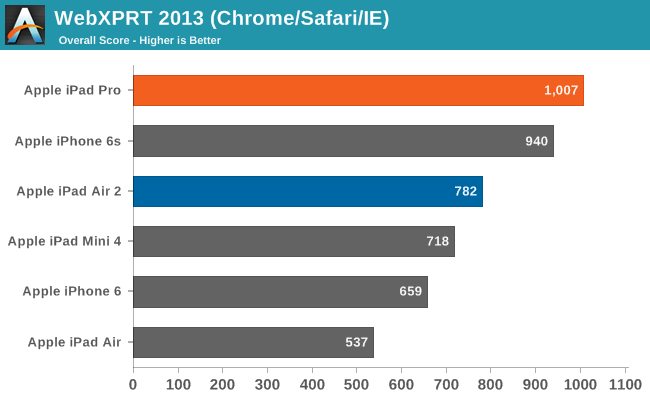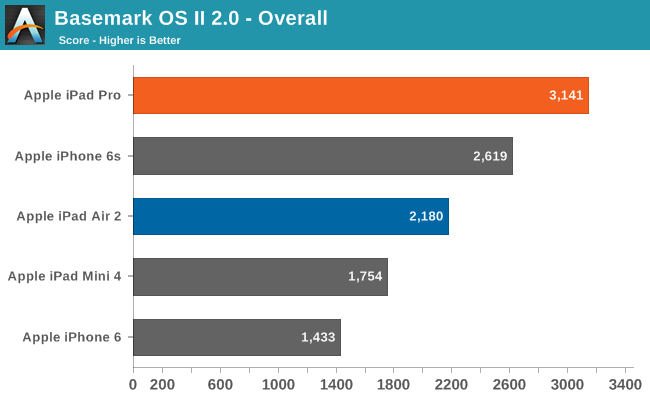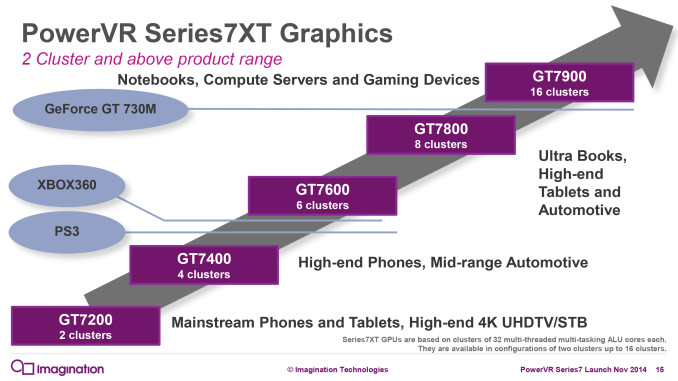The iPad Pro Preview: Taking Notes With iPad Pro
by Joshua Ho & Ryan Smith on November 11, 2015 7:00 AM ESTThe A9X SoC & More To Come
Finally, as everyone is undoubtedly eagerly anticipating our look at the A9X SoC inside the iPad Pro, let’s take a very quick look at what we know about the SoC so far. There’s a bit of a limit to what we can do blindly via just software, but I’m hoping that the eventual A9X die shots will confirm some of our suspicions on A9X’s configuration.
| Apple SoC Comparison | ||||||
| A9X | A9 | A8X | A6X | |||
| CPU | 2x Twister | 2x Twister | 3x Typhoon | 2x Swift | ||
| CPU Clockspeed | 2.26GHz | 1.85GHz | 1.5GHz | 1.3GHz | ||
| GPU | PVR 10 cluster Series7? | PVR GT7600 | Apple/PVR GXA6850 | PVR SGX554 MP4 | ||
| RAM | 4GB LPDDR4 | 2GB LPDDR4 | 2GB LPDDR3 | 1GB LPDDR2 | ||
| Memory Bus Width | 128-bit | 64-bit | 128-bit | 128-bit | ||
| Memory Bandwidth | 51.2GB/sec | 25.6GB/sec | 25.6GB/sec | 17.1GB/sec | ||
| L2 Cache | 3MB | 3MB | 2MB | 1MB | ||
| Manufacturing Process | Unknown (TSMC 16nm or Samsung 14nm) |
TSMC 16nm & Samsung 14nm |
TSMC 20nm | Samsung 32nm | ||
First and foremost, the most unexpected news here is that unlike A8X, A9X is not packing a triple-core CPU. Instead A9X drops back down to just a pair of Twister CPU cores. The twist here is that relative to A8X and A9, Apple has cranked up their CPU clockspeeds. Way, way up. Whereas the iPad Air 2 (A8X) shipped at 1.5GHz and the iPhone 6s (A9) at 1.85GHz, the A9X sees Apple push their clockspeed to 2.26GHz. Not counting the architectural changes, this is 22% higher clocked than the A9 and 51% higher than the A8X.
The fact that Apple dropped back down to 2 CPU cores is unexpected given that we don’t expect Apple to ever go backwards in such a fashion, and while we’ll never know the official reason for everything Apple does, in retrospect I’m starting to think that A8X was an anomaly and Apple didn’t really want a tri-core CPU in the first place. A8X came at a time where Apple was bound by TSMC’s 20nm process and couldn’t drive up their clockspeeds without vastly increasing power consumption, so a third core was a far more power effective option.


By comparison, with the FinFET process Apple is using here – and given the lower volume of A9X I don’t have reason to believe it’s dual-sourced, so it’s either TSMC or Samsung – Apple has been free to increase their clockspeeds substantially. At the same time these FinFET processes are still new and yields won’t be great, so there is a strong incentive to keep die sizes down to keep yields up, and adding a third core would only make that harder. If I had to guess, Apple only wanted two cores to begin with – this makes it easier for developers knowing that they only have two cores to work with – and that it’s A8X that is the anomaly.
Otherwise a highly clocked CPU is far more in-line with Apple’s design philosophy as it means that A9X is capable of amazing single-threaded performance – and keep in mind that we’re talking ARM Cortex-A57-like clockspeeds for a CPU that gets much more work done per cycle – so what we see here makes a lot of sense. Plus with iPad Pro in particular Apple has more battery capacity to sustain the power draw of a higher clocked SoC, and more surface area to dissipate that heat, so the usual concerns about power and cooling aren’t quite as pressing. I do wonder if this will impact multitasking performance much, but given what Twister is capable of, I’m not nearly ready to write off a dual-core Twister implementation clocked this high.
Moving on, as is customary for the X-series SoCs from Apple, A9X features what I believe to be a wider 128-bit LPDDR4 memory bus. The memory bandwidth numbers clearly point to a wider bus, and Apple needs the bandwidth to feed a more powerful GPU.
| Geekbench 3 Memory Bandwidth Comparison (1 thread) | ||||||
| Stream Copy | Stream Scale | Stream Add | Stream Triad | |||
| Apple A9X 2.26GHz | 20.8 GB/s | 15.0 GB/s | 15.3 GB/s | 15.1 GB/s | ||
| Apple A8X 1.5GHz | 14.2 GB/s | 7.44 GB/s | 7.54 GB/s | 7.49 GB/s | ||
| A9X Advantage | 46.4% | 101% | 103% | 102% | ||
Which brings us to the last bit of our preview, the GPU. Apple went with a 6 cluster PowerVR Series7 design on A9, and for A9X they have gone with a larger design. Without a die photo it’s basically impossible to determine how many clusters are in use since clockspeed plays such an important role. What we do know is that GPU performance relative to A9 has pretty much doubled, which once again is right in-line with Apple’s usual design goals.

Given what Apple has done with clockspeed on Twister, for the moment I am staking my bet on it being a 10 cluster design with a higher GPU clockspeed than A9 giving us the rest of the performance boost. To be clear here this could also be a 12 cluster design at a similar clockspeed or even an 8 cluster design clocked far higher – we’ll need die shots to confirm – but given all of the options it’s a 10 cluster design that is the best balance between die size and clockspeed, and it would also be the biggest curveball Apple could throw. It should also be noted that PowerVR Series7 certainly supports such a configuration since it’s scalable from 2 to 16 clusters, although in Imagination’s official product catalog they don’t have a name for such a configuration. So for the moment I’m simply calling it a 10 cluster Series7.
Anyhow, we’ll be back later with a full review of the iPad Pro, including the pros and cons of Apple’s first large-format, productivity-oriented tablet, and a full breakdown of the A9X SoC. So until then stay tuned.











199 Comments
View All Comments
lefty2 - Wednesday, November 11, 2015 - link
Wow, it scores 80 in Manhatten. The Tegra X1 can only score 56.9 in the same test: http://www.anandtech.com/show/9289/the-nvidia-shie...lefty2 - Wednesday, November 11, 2015 - link
Sorry, 65 - read the wrong graphdennis.forbes - Wednesday, November 11, 2015 - link
"in retrospect I’m starting to think that A8X was an anomaly and Apple didn’t really want a tri-core CPU in the first place"The A9X looks absolutely brilliant, and is another winner from Apple, however I wish we didn't have to find retroactive justifications for everything Apple does, or why every decision they make is intrinsically correct.
Apple has a given die size and a given power consumption profile. They design their SoC accordingly. I doubt they "want" 2 or 3 (or 4 or 8 or 16) cores intrinsically, but it ends up being decided by the preceding restrictions, and in this case it was 2 fast cores with a very large, very powerful GPU. I have no doubt they'll move to 3 cores next year, as optimizations and restructuring presents itself, and again we'll hear why 3 cores is really what they wanted.
Aenean144 - Wednesday, November 11, 2015 - link
Think of it from the outside in.What workloads will benefit or require 3 cores or 4 cores. If they want to support workstation workloads, moving to 4 core might be the right way to go. If you have smartphone workloads, 2-core. Tablet workloads, hmm.
Waiting on FCPX, Logic, Xcode, etc for iOS to drop. If Apple intends on that happening, odds are pretty durn good that iOS laptop, like a MBP, will also come.
tipoo - Wednesday, November 11, 2015 - link
These are two sides of the same coin really, but I'm sure Apple would have avoided scaling to three cores if they could have had that performance in two at the die size. Even with automatic management of loads the third core won't scale nearly as well as the second one (nor the fourth, etc), Amdahl's law and all that.Aenean144 - Wednesday, November 11, 2015 - link
20 years from new Joshua, you are going to be looking at your notes and thinking, "WTF!" The rosetta stone in your head that makes that scribble legible is going to be long lost to make room for all the more advanced stuff you have to learn. ;)One of the holy grails of pen computing I've been waiting for is seamless conversion of analog drawing input into vector graphics and fonts so all that cursive becomes legible in the future. Might give handwritten note taking another shot if there was an app that can do this. Sort of like an iWork app mashup where hand-input tables, drawings, notes, spreadsheets, images, etc are all first class citizens.
FunBunny2 - Wednesday, November 11, 2015 - link
-- One of the holy grails of pen computing I've been waiting for is seamless conversion of analog drawing input into vector graphics and fonts so all that cursive becomes legible in the future. Might give handwritten note taking another shot if there was an app that can do this. Sort of like an iWork app mashup where hand-input tables, drawings, notes, spreadsheets, images, etc are all first class citizens.If you visit any R textbook, there you'll find "simple" examples of doing just that.
xthetenth - Wednesday, November 11, 2015 - link
I'm really glad to see note-taking capability that's actually superior to pencil and paper is finally coming to iOS, it's been a badly needed bit of functionality for a long time, and should help make their tablets more than souped-up big phones. I feel that by the time you're carrying around a device that doesn't fit in your pocket, and definitely one in the 10+ inch range, you should be getting the ability to do more things than with something that fits in your pocket, rather than the ability to do things a bit better. Hopefully Apple will eventually make something that doesn't mandate carrying a tablet and a laptop if you want a tablet but have to get a bit of serious work done, it makes a mockery of the effort they put into making their devices thin and light, since currently there's no contest between a Surface (Pro) and an iPad Air (with an MBP stuffed in there too).Wineohe - Wednesday, November 11, 2015 - link
Hmm I'm in a conundrum as I read this article on the cracked screen of my ipad3 and at the same time pondering the replacement of my aging Lenovo X220. Yes I know I'm behind the times. However spending another grand on a tablet with the limitations of iOS and the the lack of even basic IO is not attractive. A convertible laptop or the like with a real OS geared toward productivity seems way more appealing, since that is what the Pro is starting to compete with. Help me out folks, what am I missing.melgross - Wednesday, November 11, 2015 - link
It's a use case. If you need to do something beyond what the system can manage, then it's not for you.I'm seeing complaints that a numher of apps aren't as full as their Desktop versions. But what limitation is that, really? Even on a Surface Pro 4 the size is a limitation for many things. So what? Adobe, Autodesk, and others, allow you to store your work in their cloud, where it appears in their Desktop software for more sophisticated work. That works well, if you need to do more sophisticated work.
So I think you need to look carefully at what you really need to do, and see if the apps available will allow that. It will take some effort to do that exploration, but that's nothing new. In addition, these devices will continue to get better with time. Now that the hardware is there, it's a matter of software, both on the OS and app end. I've been beta testing iOS 9.2, and it adds some features that the Pro, with 9.1 don't yet have. Next year's iOS 10 will do more. That's just the nature of things.